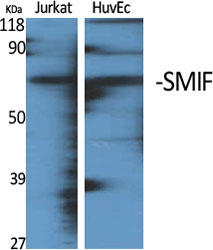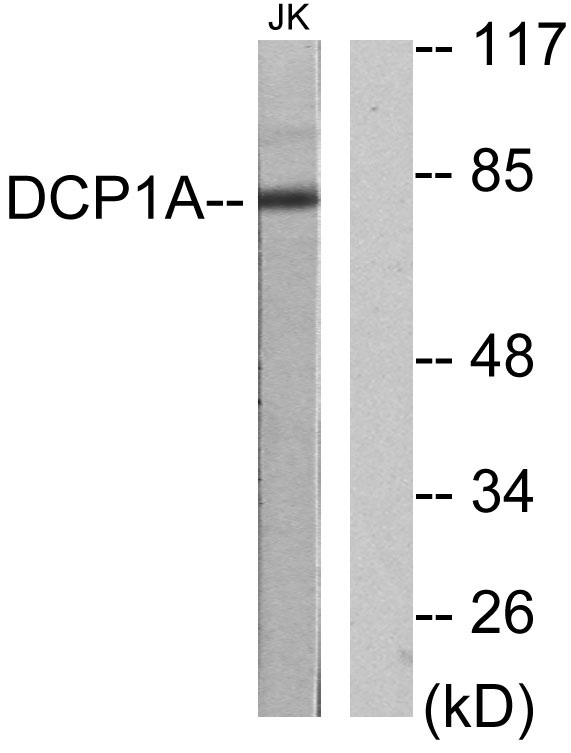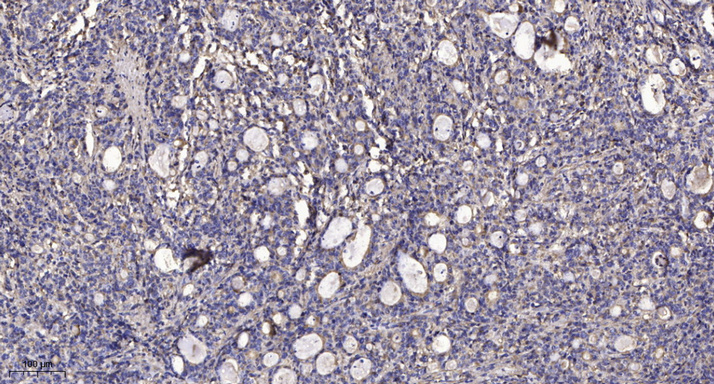SMIF Polyclonal Antibody
- Catalog No.:YT4343
- Applications:WB;IHC;IF;ELISA
- Reactivity:Human;Mouse
- Target:
- SMIF
- Fields:
- >>RNA degradation
- Gene Name:
- DCP1A
- Protein Name:
- mRNA-decapping enzyme 1A
- Human Gene Id:
- 55802
- Human Swiss Prot No:
- Q9NPI6
- Mouse Gene Id:
- 75901
- Mouse Swiss Prot No:
- Q91YD3
- Immunogen:
- The antiserum was produced against synthesized peptide derived from human DCP1A. AA range:111-160
- Specificity:
- SMIF Polyclonal Antibody detects endogenous levels of SMIF protein.
- Formulation:
- Liquid in PBS containing 50% glycerol, 0.5% BSA and 0.02% sodium azide.
- Source:
- Polyclonal, Rabbit,IgG
- Dilution:
- WB 1:500 - 1:2000. IHC 1:100 - 1:300. ELISA: 1:20000.. IF 1:50-200
- Purification:
- The antibody was affinity-purified from rabbit antiserum by affinity-chromatography using epitope-specific immunogen.
- Concentration:
- 1 mg/ml
- Storage Stability:
- -15°C to -25°C/1 year(Do not lower than -25°C)
- Other Name:
- DCP1A;SMIF;mRNA-decapping enzyme 1A;Smad4-interacting transcriptional co-activator;Transcription factor SMIF
- Observed Band(KD):
- 75kD
- Background:
- Decapping is a key step in general and regulated mRNA decay. The protein encoded by this gene is a decapping enzyme. This protein and another decapping enzyme form a decapping complex, which interacts with the nonsense-mediated decay factor hUpf1 and may be recruited to mRNAs containing premature termination codons. This protein also participates in the TGF-beta signaling pathway. Alternative splicing of this gene results in multiple transcript variants. [provided by RefSeq, Feb 2014],
- Function:
- function:Necessary for the degradation of mRNAs, both in normal mRNA turnover and in nonsense-mediated mRNA decay. Removes the 7-methyl guanine cap structure from mRNA molecules, yielding a 5'-phosphorylated mRNA fragment and 7m-GDP. Contributes to the transactivation of target genes after stimulation by TGFB1.,similarity:Belongs to the DCP1 family.,subcellular location:Predominantly cytoplasmic, in processing bodies (PB). Nuclear, after TGFB1 treatment. Translocation to the nucleus depends on interaction with SMAD4.,subunit:Forms a complex with EDC3, DCP2, DDX6 and EDC4/HEDLS, within this complex directly interacts with EDC3. Binds DCP1B, UPF1 and SMAD4. Part of a cytoplasmic complex containing proteins involved in mRNA decay, including XRN1 and LSM1. Interacts with PNRC2.,tissue specificity:Detected in heart, brain, placenta, lung, skeletal muscle, liver, kidney and pancreas.,
- Subcellular Location:
- Cytoplasm, P-body . Nucleus . Co-localizes with NANOS3 in the processing bodies (By similarity). Predominantly cytoplasmic, in processing bodies (PB) (PubMed:16364915). Nuclear, after TGFB1 treatment. Translocation to the nucleus depends on interaction with SMAD4 (PubMed:11836524). .
- Expression:
- Detected in heart, brain, placenta, lung, skeletal muscle, liver, kidney and pancreas.
- June 19-2018
- WESTERN IMMUNOBLOTTING PROTOCOL
- June 19-2018
- IMMUNOHISTOCHEMISTRY-PARAFFIN PROTOCOL
- June 19-2018
- IMMUNOFLUORESCENCE PROTOCOL
- September 08-2020
- FLOW-CYTOMEYRT-PROTOCOL
- May 20-2022
- Cell-Based ELISA│解您多样本WB检测之困扰
- July 13-2018
- CELL-BASED-ELISA-PROTOCOL-FOR-ACETYL-PROTEIN
- July 13-2018
- CELL-BASED-ELISA-PROTOCOL-FOR-PHOSPHO-PROTEIN
- July 13-2018
- Antibody-FAQs
- Products Images

- Western Blot analysis of various cells using SMIF Polyclonal Antibody

- Western blot analysis of lysates from Jurkat cells, using DCP1A Antibody. The lane on the right is blocked with the synthesized peptide.

- Immunohistochemical analysis of paraffin-embedded human Gastric adenocarcinoma. 1, Antibody was diluted at 1:200(4° overnight). 2, Tris-EDTA,pH9.0 was used for antigen retrieval. 3,Secondary antibody was diluted at 1:200(room temperature, 45min).



